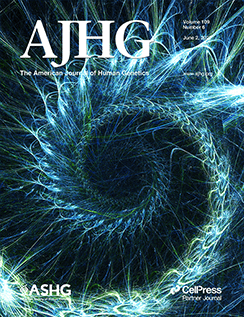EndoPRS: Incorporating endophenotype information to improve polygenic risk scores for clinical endpoints-A study in asthma.
IF 8.1
1区 生物学
Q1 GENETICS & HEREDITY
引用次数: 0
Abstract
Polygenic risk score (PRS) prediction of complex diseases can be improved by leveraging related phenotypes. This has motivated the development of several multi-trait PRS methods that jointly model genetically correlated traits. However, these methods do not account for vertical pleiotropy, where one trait acts as a mediator for another. Here, we introduce endoPRS, a weighted lasso model that incorporates information from relevant endophenotypes to improve disease risk prediction without making assumptions about the genetic architecture underlying the endophenotype-disease relationship. Through extensive simulation analysis, we demonstrate the robustness of endoPRS in a variety of complex genetic frameworks. We also apply endoPRS to predict the risk of childhood-onset asthma in UK Biobank and All of Us by leveraging a paired genome-wide association study of eosinophil count, a relevant endophenotype. We find that endoPRS significantly improves prediction and transferability compared to many existing PRS methods, including multi-trait PRS methods MTAG and wMT-BLUP, which suggests advantages of endoPRS in real-life clinical settings.EndoPRS:结合内表型信息提高哮喘临床终点的多基因风险评分。
多基因风险评分(PRS)对复杂疾病的预测可以通过利用相关表型得到改善。这推动了几种多性状PRS方法的发展,这些方法共同模拟遗传相关性状。然而,这些方法不能解释垂直多效性,在垂直多效性中,一个性状作为另一个性状的中介。在这里,我们引入了endoPRS,这是一个加权套索模型,结合了相关内表型的信息,在不假设内表型与疾病关系的遗传结构的情况下,提高了疾病风险预测。通过广泛的模拟分析,我们证明了endooprs在各种复杂遗传框架中的鲁棒性。我们还通过利用嗜酸性粒细胞计数(一种相关的内表型)的配对全基因组关联研究,在UK Biobank和All of Us中应用endoPRS来预测儿童发作哮喘的风险。我们发现,与许多现有的PRS方法(包括多性状PRS方法MTAG和wMT-BLUP)相比,endoPRS显著提高了预测和可转移性,这表明endoPRS在现实临床环境中的优势。
本文章由计算机程序翻译,如有差异,请以英文原文为准。
求助全文
约1分钟内获得全文
求助全文
来源期刊
CiteScore
14.70
自引率
4.10%
发文量
185
审稿时长
1 months
期刊介绍:
The American Journal of Human Genetics (AJHG) is a monthly journal published by Cell Press, chosen by The American Society of Human Genetics (ASHG) as its premier publication starting from January 2008. AJHG represents Cell Press's first society-owned journal, and both ASHG and Cell Press anticipate significant synergies between AJHG content and that of other Cell Press titles.

 求助内容:
求助内容: 应助结果提醒方式:
应助结果提醒方式:


